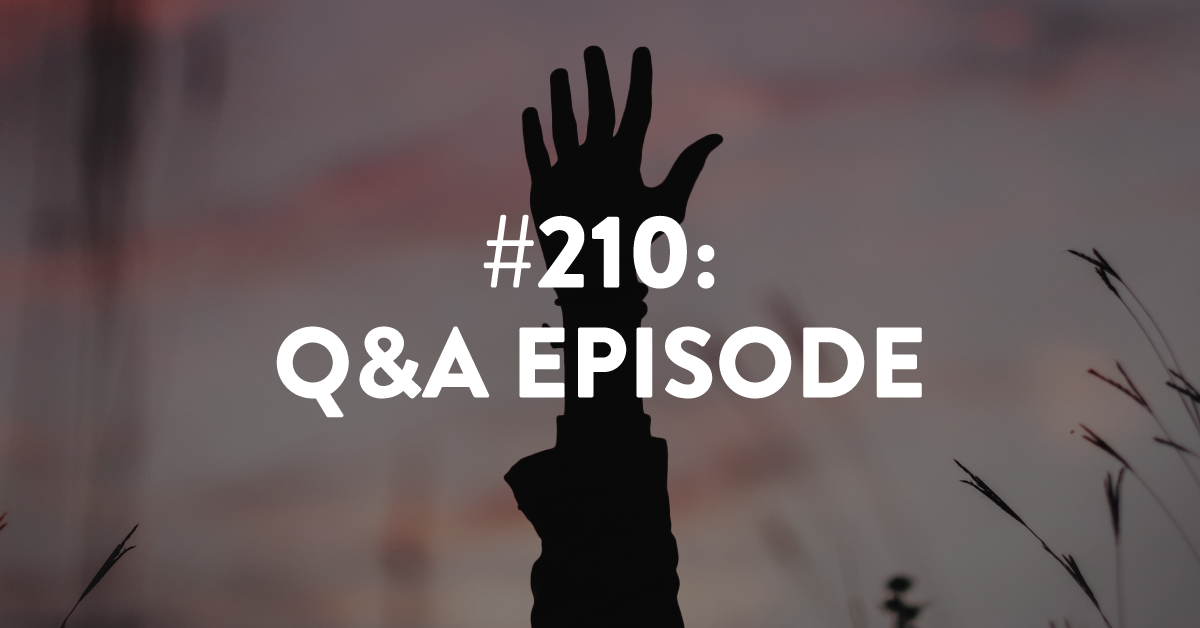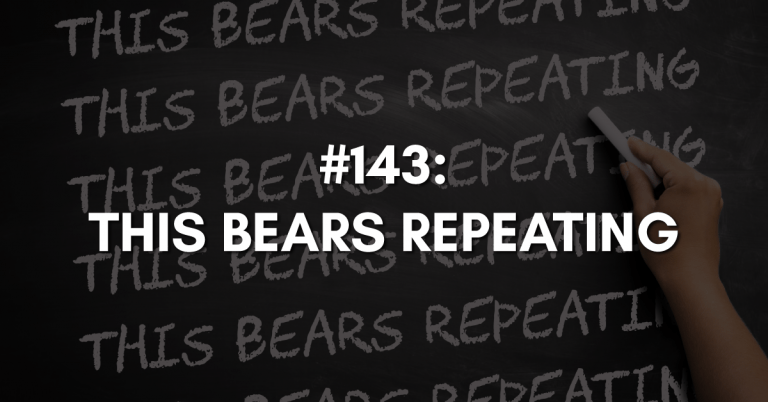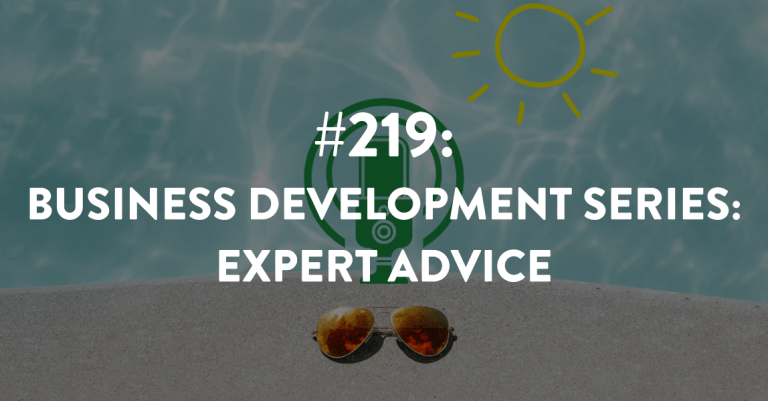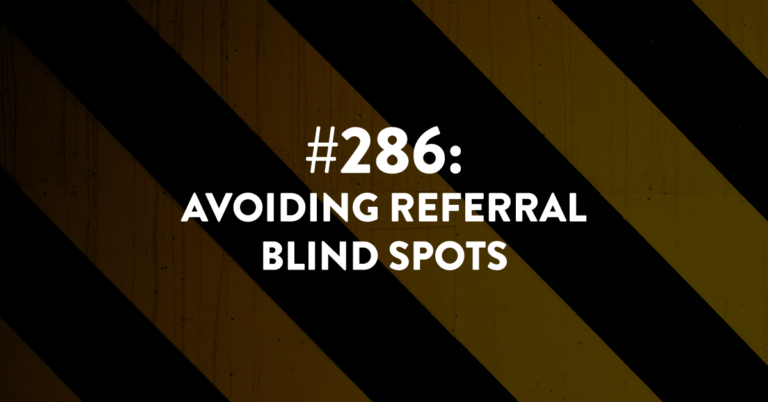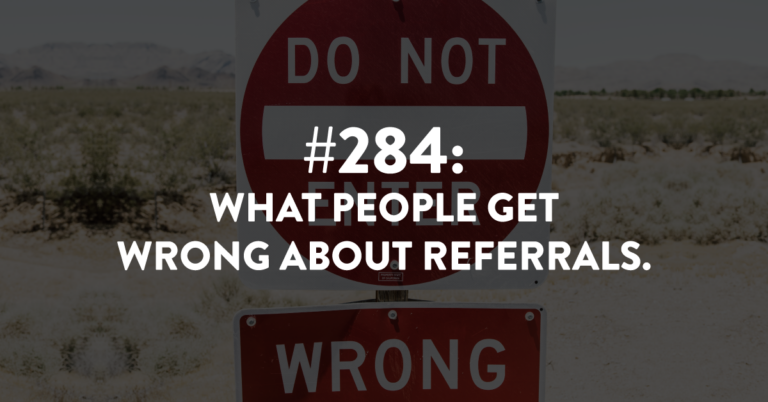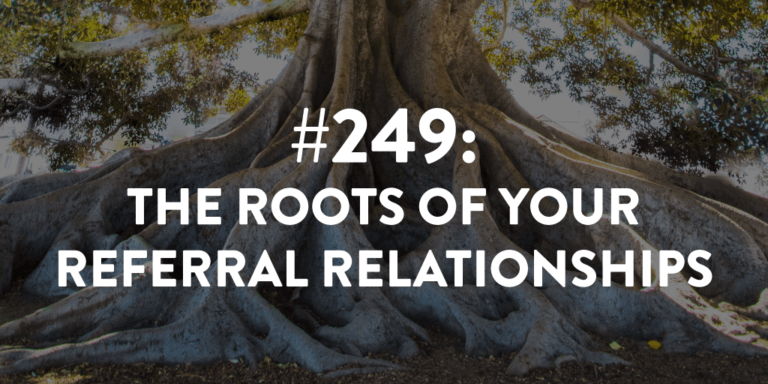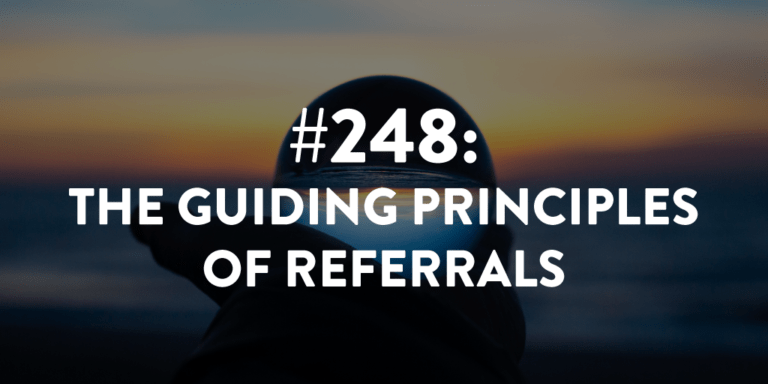Ep #210: Q&A Episode
You’ve got questions and I’ve got answers on today’s Q&A episode.
First, we will be discussing the benefit of creating unique thank you cards for your referral sources to encourage them to refer you again. I will also explain what makes a touchpoint meaningful and powerful enough to encourage referrals in the future without coming across as over-the-top or a bribe.
Next, we will discuss the different stages clients go through and the various touchpoints that will be associated with each stage. Remember, it’s up to you to take control and grow your business.
Links Mentioned During the Episode:
Looking for Referral & Client Experience Resources:
Take the Referral Ninja Quiz to test your skills and abilities at generating referrals. (FREE)
Buy my book – Generating Business Referrals Without Asking – and learn how to generate referrals through my 5 steps. (LESS THAN $16)
Consider joining Building a Referable Business™ – a unique way to learn all of my referral strategies and tactics with ongoing weekly access to me to answer your questions and help hold you accountable! Email me for more details.
Coming Up:
Next episode is #211, and it’s time for our business development series.
Download The Full Episode Transcript
Read the Transcript Below:
Stacey Brown Randall: You’ve got questions? Well, I’ve got answers. It’s another Q&A episode. Let’s dive in.
You are not just another hustling salesperson. You are the expert, the
resource, the valuable partner for your clients, and how you grow your
business should reflect how your clients see you.
Welcome to the Roadmap to Grow Your Business podcast. We generate
referrals without asking, build positive client experiences, and help
you take control of your business.
Here’s your charmingly sarcastic host, Stacey Brown Randall.
Stacey Brown Randall: Hey there, and welcome to episode 210 of the Roadmap to Grow Your Business Podcast. I’m your host, Stacey Brown Randall.
You know what happens when it’s the 10th episode or about every 10th episode? I answer your questions. Yep, questions that you guys submit through my Referrals Without Asking Facebook group, or maybe it’s questions that you guys send me directly via email. Sometimes it’s questions that I get asked by my clients who are in my different programs, like Growth by Referrals or Referring Machines or Building a Referral Business.
I take those questions that you guys ask me and the ones that I really think would be helpful for the listeners (you) of this podcast, I answer them and we do this about every 10th episode. So, 210 means it’s time to answer some questions and I’ve got three for you today. But real quick, before we dive into these question and answers, I want to give a quick shout out to Melissa.
Melissa is a real estate agent and she is in my Building a Referral Business Program. She has applied two foundational strategies. That’s the ones that she’s learned in Growth by Referrals and Referring Machines.
Now, she has been in BRB since we launched it last year, but I was actually working with her a year prior. So, she’s really in her second year of continuing to develop her referral strategies.
So, she’s been applying these two foundational strategies, the ones you learn in GBR (Growth by Referrals), which is how to get more referrals from your existing referral sources, and Referring Machines, meaning how you turn new people into referral sources. How you get clients and contacts, COIs to refer you.
And now, she’s starting to tackle my other foundational strategy, which is being referable within your client experience, which is Referable Client Experience. Now, that program is only available to the members of Building a Referral Business, but I’m so excited that she’s been applying these two foundational strategies for about … it hasn’t been two full years. So, she’s in her second year — well, into her second year.
But I was just so excited that her two strategies, she continues to do. She learned them in her first year, implemented them, had a great first year with referrals. Now, she’s in her second year, she’s continuing to implement those referral strategies and she has received 17 referrals in just the first few months of the year.
Now, for all of you real estate agents listening, you know 17 referrals in just a few months, and if you have a high closing ratio of those referrals, there’s the potential for a lot of commission. This isn’t every referral is worth $1,500 for her. If you’ve ever worked with a real estate agent, you know what the commission looks like. If you are a real estate agent, you know what that looks like.
So, we’re talking about hundreds of thousands of dollars, and it’s all coming through because she’s continuing to work her referral strategies. She’s doing so amazing, but also, I’m really excited because since she’s in BRB (Building a Referral Business), she’s now diving into the last foundational strategy Referable Client Experience.
And then of course, we’ll help her refine as she goes along, we’ll help hold her accountable as she moves into maintenance mode. And then of course, we’ll tackle some next level and situational referral strategies as well. But Melissa, congratulations, my dear. You are doing amazing.
Alright, let’s dive into these three questions. Two are pretty quick. So, I’m going to start with those, and then we’ll end with the question that’s a little bit media.
Alright, so the first question comes from a financial advisor. He had actually heard me on a podcast. I was interviewed on another podcast that is the audience of that podcast is for financial advisors.
And then of course, that got him started maybe like paying attention a little bit to my website and to the book that I have. He went ahead and bought I think the audio version of the book.
So, as you can imagine, his questions come because he is immersing himself in my philosophy and what I teach and the strategies that I help clients deploy. So, his questions aren’t like the basics that I sometimes get when people haven’t either listened to me do a podcast episode where I’ve been interviewed and I’m explaining the basics, or they’ve read my book.
That kind of gives you a good foundation of where to start or listening to this podcast, gives you a good foundation of where to start. So, these questions are a little bit more in depth, but they’re still really good questions because they’re probably ones that you’ve thought about as you’ve thought through some of the things.
His first question is how powerful are custom made cards in addition to them being handwritten?
And the reason why he asked is because his wife makes the most beautiful hand drawn cards. I mean, they’re like works of art, and I know this because he attached one so that I could see it, which I really appreciate, because it was really pretty and really cool.
And so, that’s not a typical question you’re going to ask. When I say do a handwritten thank you card, most people are like, “Do I have to hand write it? Can someone hand write it for me? Can my logo be on the card?” Like those are the difficult questions we get when people hear me teach. You must send a handwritten thank you card after every referral is received.
But this question, this first question, he was asking about handmade cards or custom-made cards because he has access to that with his wife who hopefully is willing to make these cards for him.
So, it’s a very specific question that you may not have thought of until you actually start about writing thank you notes if you had access to someone like he does, his wife, who makes these cards, and they are absolutely beautiful. And I do think they will add impact, especially when he can make a note about the fact that they were created by his wife.
So, my recommendation was yes, use them. One, they’re beautiful. Two, use those cards. Yes, I think they’ll add an additional impact in addition to what you’re writing inside the card. But what will ultimately make the impact of them understanding how special these cards are is that there should be a note about them. Like maybe on the back that they were made by love by his wife and then maybe include her name.
So, I think the fact that those cards are handmade by his wife should not be lost. And so, to have the impact though, they need to know why that makes them so special because they’re handmade by his wife, not just cards he picked up. In the store, that looked like beautiful pieces of art.
So, I think that question was very specific for what he had, but it may get you guys thinking about some cool ways you can do your thank you cards as well.
His second question, so he had a second question — he said is a thoughtful gift going too far into looking like a bribe?
This is a question we’ve tackled before, but I haven’t talked about it in a while, so I’m excited to talk about this one for you guys. For example, if a referral source that I know likes to read, then sending an appropriate book, but does that look like a bribe?
And I said this is how I want him to think about and how I want you to think about what I teach inside my programs. Now, he’s not a client inside my program. So, he hasn’t had the benefit of understanding the four-part framework of how we create the touch points that we’re going to do for our referral sources, which are backed by science and psychology and behavior economics.
And so, he doesn’t know how we build out these thoughtful touch points that are memorable and meaningful because he hasn’t been exposed to that information. So, it’s a normal question to think through, wait, I know you’re talking about doing touch points. Most people initially think, well, you must be talking about gifts. I am not.
I tell most people you need a variety of touch points, of course. You should not be doing four to eight gifts in a year to people. That’s weird and it does come off like you’re trying too hard.
And so, what I wanted him to understand is one, a gift is just one type of the touch points that I teach my students in my programs. So, it’s not going too far and looking into a bribe because you’re not doing it every single time and you’re not sending it because they sent you a referral.
And I think that’s the thing that people need to understand is that one, the key to a memorable and meaningful touch point and to a referral plan that is memorable and meaningful is variety in what you do for your referral sources. But it’s a set plan that we set at the beginning of the year or at some point, 4, 12 months.
So, there is a cadence to it, there is consistency to it, but there’s space in it as well, like four to eight touch points, most people fall in that five, six, maybe seven range in their first year. And so, there’s a cadence to it. And those touch points are going to happen regardless if they’ve just referred you or not. They’re going to happen based on how you’ve built out the calendar.
So, if you said in August, I’m going to send a bit my favorite business book, then you are going to do that in August no matter when their referrals have happened. So, not understanding how we teach the referral plan and the science behind it and the cadence behind it and how it works, obviously, leads for people to have questions like he has.
So, we know that our goal is to take care of our referral sources because they take care of us. And because we can’t always refer people who refer to us, this is what we do instead of that. We create this beautiful referral plan of outreach, of touch points that let them know how much we appreciate them. But we do it in a way that is backed by science, behavior economics, and psychology, so that we know that we’re having the impact we ultimately want.
So, a lot of people think, well, if I send a gift card or I send a book, is it looking like a bribe? Not if it’s part of a concerted plan and not if it’s a one off. Because this is built to take care of the people who take care of us.
This is how we do that. And so, the idea though about any touch point you do with the way that I teach it, there’s a big deal about surprise and delight, right. Like the surprise and delight factor is a really big deal as a touch point within the plan.
But here’s the thing, if you don’t have a referral plan and you don’t have your five, six or seven touch points that you’re doing, and there isn’t variety and isn’t memorable and meaningful, and you don’t have the framework of how that works with what you do and the language that you do, all the things that I teach in Growth by Referrals, that’s okay.
If you’re wanting to say thank you to a referral … I mean, it’s okay, as in like it’s okay, you can still learn it. And it doesn’t mean like something’s wrong. I still want you to learn it, right, and obviously, do it. But if you’re thinking about this as someone sent me a referral, now I want to send them a book, does that come across as a bribe? It’s all about the surprise and delight factor, and if it’s done right.
And if it’s done right, and it’s surprise and delight, it’s never seen as a bribe, but as a thoughtful thank you. Sometimes we overthink these things because we’re not paying attention to actually how they are received. So, if you know somebody who’s referred you as a book lover and you want to send them a book to say, thank you for the referral they just sent, that’s fine.
But you also don’t have to feel like you’re now stuck sending them a book every time they refer you. But that is also the cadence that you’ve now set up, which is why I teach when someone refers you, send them a handwritten thank you note, because that’s all you got to remember to do. Because you’re taking care of them in that memorable and meaningful way with your touch point plan because they are a referral source and they’re getting those five or six touch points from you in a year.
So, that’s why you don’t have to worry about sending a gift that in this case maybe feels like a bribe, but it shouldn’t, to a referral source when they refer you. And keeping up with that can be tough as well.
Let’s move on to our third question. Our third question comes from a real estate agent who is in our Referrals Without Asking Facebook group. That’s our free Facebook group, and you guys can join it, if you’re not in it.
Just go to staceybrownrandall.com/community and it’ll redirect you to the Referrals Without Asking Facebook group over on Facebook. You do got to answer three questions to get in.
So, she has listened to the series that we did last summer. I try to theme out a topic for this summer series. Last year, it was client experience. I think the year before or the year before that, it was like the big no-nos of referrals. And this year, it’s actually going to be our business development. It’s going to be talking about different things to consider from sales or our business development. That’s our series theme for this year.
But Pamela had listened. Again, she’s a real estate agent. She had listened to the client experience series that we did last summer. She just recently listened to it and she was trying to come up with personal touches that she can do as a real estate agent.
The first piece of recommendation that I gave her is the touch points that you do as part of your client experience, so this is totally separate from what you’re doing as touch points for referral experience. Remember, referral experience touch points only happen for people who have referred you and you’re taking care of them to cultivate more referrals from them.
Your client experience happens for every client, whether they’ve referred you or not, but it makes you referable if you have a referral client experience. And part of that is having a good mix of yes, you’ve got your work touch points, but making sure you mix in relationship building touch points as well.
This is best understood by looking at the different stages a client goes through in your business. Now, different people break down the client experience stages in different ways. I keep things uber-simple because I know that’s how we can rationalize. Like we can think about it logically in our brains.
So, I look at three stages: new, active, alumni. And if your client stay with you forever like a financial advisor or CPA, then of course maybe it’s just new and active. And the best touch points that you should be considering in those moments come, of course, from really paying attention to what’s happening in that stage.
But here’s the thing touch points aren’t built within your client experience because you’re just trying to figure out how you can like stay connected to them or like have an outreach. That’s not the point. Each stage is trying to overcome something in their head.
And if your touch points, particularly the relationship building touch points, are helping you overcome whatever thing they’re circling in their head that they’re not verbalizing to you in that moment, it’s going to make your client experience better for them and making you more referable in the process.
For example, in the new client stage, they’re overcoming buyer’s remorse. Did I hire the right agent? Did I buy the right course or training? I’m I sure this person can manage my money correctly? Did I make the right investment? Is this the interior designer that can really give me the kitchen of my dreams?
Whether they’re excited to hire you or not, everybody has that moment of, “Ooh, did I make the right decision? Is a lot of money, did I make the right decision?” So, new stage touch points are not built just willy-nilly, let’s do some things in the new stage to have some relationship building touch points as part of our client experience. They’re built to overcome buyers’ remorse. And so, the touch point should reflect that.
So, one example that I always talk to folks about within the new stage is considering like a welcome card or sometimes the clients of mine who are in referable client experience, and now I talk about this as a journey card. But a welcome card to working with you isn’t like, “So glad you’re a client, sign my name, send it out.” Like that’s average. I mean, technically I guess there’s nothing wrong with it. It’s better than nothing.
But you could also use that card and what you write in that card to overcome any buyers’ remorse that they may be having or any hesitations that they may be having about working with you or the process to work with you.
So, as an agent, Pamela would want to make sure that her welcome card is talking about the highs and lows of trying to sell a house or trying to buy a house, and that she’s there with them. That would be the idea of what that would look like in the new client stage.
One of the things to consider in the active stage, and I’m not giving the definitions, because guys they’re all last summer in episodes 151 through 164, so you guys can go check those out. But in the active stage, that’s when the work really begins. The new stage is over, now, we’re in the active stage and some people can be in the active stage for 30 days or for a whole year or for 18 months.
And so, your active stage and what you do for touch points that are relationship based ones, that make you sticky, those really start to take on a different look and feel because of how long your active stage is.
So, one of the best practices I always talk about are celebration touch points within the active stage, not at just the end of the active stage when they’re now officially done and they’re moving into alumni. But something that’s more celebration touch points. Looking for those moments to celebrate things through the process is really important when you think of active stage touch points.
And then finally, for those of you who actually finish the work with your clients and they do become alumnis, right, one classic example I always tell folks to do in the alumni stage, and of course, this would fall for any client, no matter what stage they’re in, because it’s calendar-based, but really, something that you know your alumni clients are no longer with you will continue to receive to stay connected to you.
It’s not the only touch point in the alumni stage, it’s just one of my favorites, is really personalized holiday cards. And I’m not talking about the cards you buy at the store with a pack of 50 and you sign your name. I’m talking about you going the extra mile and creating a card that is either you and your team. So, if Pamela has a real estate team or people who help her, could be a card of her and her team, or it being you and your family.
However, you define family; you and your 12 dogs, you and all the humans that you love, whatever you define as family. We do this every year, and personally for me, where we go above and beyond which other people should never feel any kind of obligation to do with our holiday cards, but it becomes a card that people look forward to. It also means it’s a card that stresses me out every year and the stress starts like right about now.
Late spring, early summer, I’m like, “Oh my gosh, I have to do another card this year.” But make it personalized. Put you on it. Put your family on it. However you define that, put your employees on it, make it personalized because the cards that have people on them are the ones that get looked at a second glance. And they’re also typically the ones that are more likely to make the wall of Christmas cards or the doorframe of Christmas cards, like it happens to be in our house.
So, that’s one that you can do in the alumni stage. Of course, any client who’s in the new stage or the active stage, when the holidays roll around, they would get that card as well. So, that’s just a couple of examples. Pamela, thank you so much for your question.
So, those are our three questions answered. If you have more questions, you guys know what to do. Hop into the Referrals Without Asking Facebook group and post a brand-new post and ask me your question. I will either answer it right then in the group or I’ll answer it and then tell you I’ll also be answering it here on the podcast.
Remember, all of the things that we talked about in today’s episode can be found on the show notes page, including the transcript. So, if listening is not your jam and you want to read, the transcripts are there. You can either scroll through the entire transcript right there on the show notes page or download the transcript to read on your own time. That’s @staceybrownrandall.com/210.
Alright, now, my friends, we’re getting ready to dive in to a business development series. Going to be fun. We’re going to have a good time with it in the summer. It’s coming up and it’s not too late to submit your questions and it’s not too late to submit the topics you want to make sure I cover.
We talk about all things, sales and business development. We’re going to be talking about messaging. We’re going to be talking … right, of course; we’re going to be talking about messaging. We’re going to be talking about sources. We’re going to talk about what it looks like and your buyer’s journey, all the things that are necessary to have a thriving pipeline of prospects turning in to clients.
So, it’s not too late to submit your questions. Submit your topics that you want us to cover in our business development series. So, until then my friends, take control and grow your business. Bye for now.
Thanks for listening to the Roadmap to Grow Your Business podcast. To
access all resources and links mentioned in today’s show, and to
connect with Stacey, head over to www.staceybrownrandall.com.

